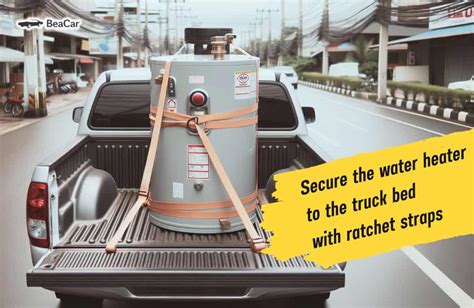How To Transport Water Heater
Ronan Farrow
Mar 20, 2025 · 3 min read

Table of Contents
How to Transport a Water Heater Safely and Efficiently
Moving house? That means tackling the often-overlooked task of transporting your water heater. This isn't your average furniture move; water heaters are heavy, bulky, and contain potentially hazardous components. This guide will walk you through the process safely and efficiently, ensuring your water heater arrives at its destination in one piece.
Preparing Your Water Heater for Transport
Before you even think about lifting, you need to prepare your water heater for the journey. This crucial step significantly reduces the risk of damage and leaks.
1. Drain the Tank:
This is the most important step. A full water heater tank is incredibly heavy and prone to leaking during transport. Completely drain the tank by turning off the power supply (electric water heaters) or gas supply (gas water heaters), then opening the drain valve located at the bottom of the tank. Allow ample time for complete draining.
2. Secure Loose Parts:
Check for any loose parts, such as the drain valve, temperature and pressure relief valve, or anode rod. Tighten any loose connections to prevent them from vibrating loose during transport. Consider using plumber's tape for extra security.
3. Protect the Tank:
Water heaters are vulnerable to scratches and dents. Wrap the tank in several layers of protective padding, such as blankets, bubble wrap, or moving pads. Pay particular attention to corners and edges.
4. Secure the Straps:
Use strong moving straps or ratchet straps to secure the water heater to the transport vehicle. Ensure that the straps are tightly secured and evenly distributed to prevent shifting during transit.
Choosing the Right Transport Method
The best transportation method depends on the size and type of water heater, as well as the distance of the move.
1. Professional Movers:
For larger, heavier water heaters or longer distances, consider hiring professional movers. They have the right equipment and expertise to handle heavy appliances safely and efficiently. This minimizes the risk of damage and liability.
2. DIY Transport (with caution!):
For smaller, lighter water heaters and shorter distances, DIY transport is possible, but proceed with extreme caution. Never attempt to lift a water heater alone. You'll need at least two strong people and appropriate lifting techniques. Ensure your vehicle is large enough to accommodate the water heater securely.
3. Proper Securing in the Vehicle:
Regardless of the transport method, proper securing is vital. The water heater should be firmly secured to prevent any movement during transport. Use straps, blocks, and padding as needed.
Handling and Installation at the Destination
Once you arrive at your new location, carefully reverse the process.
1. Careful Unloading:
Carefully unload the water heater using the same techniques employed for loading. Avoid dropping or jarring the unit.
2. Inspect for Damage:
Thoroughly inspect the water heater for any signs of damage. If any damage is found, do not install it.
3. Professional Installation (Recommended):
While you might be tempted to install it yourself, it's strongly recommended to hire a qualified plumber to install the water heater. Incorrect installation can lead to leaks, safety hazards, and voiding warranties.
Safety First!
Remember, safety is paramount when transporting a water heater. Always prioritize safety over speed and convenience. If you're unsure about any aspect of the process, it's always best to seek professional help. A small investment in professional help can prevent costly repairs or even injuries.
Featured Posts
Also read the following articles
| Article Title | Date |
|---|---|
| How To Unbind A Key In Rust | Mar 20, 2025 |
| How To Use Digital Backdrops | Mar 20, 2025 |
| For How Long Is Cpr Certification Valid | Mar 20, 2025 |
| How To Train Your Dragon 2 Subtitles | Mar 20, 2025 |
| How Do You Get A Motorcycle License In Kansas | Mar 20, 2025 |
Latest Posts
Thank you for visiting our website which covers about How To Transport Water Heater . We hope the information provided has been useful to you. Feel free to contact us if you have any questions or need further assistance. See you next time and don't miss to bookmark.
